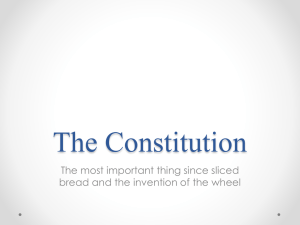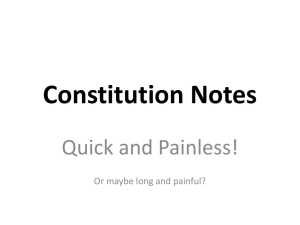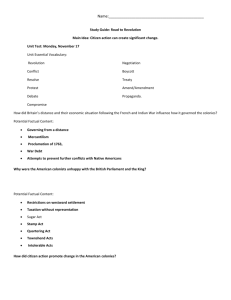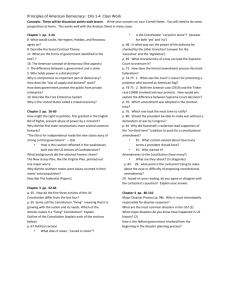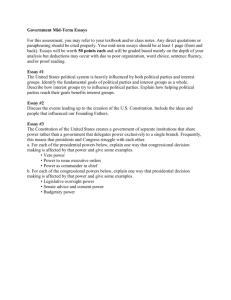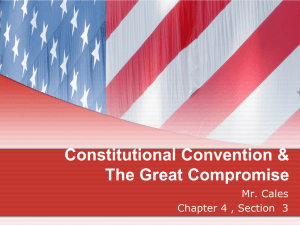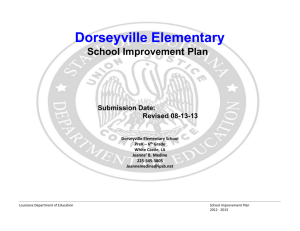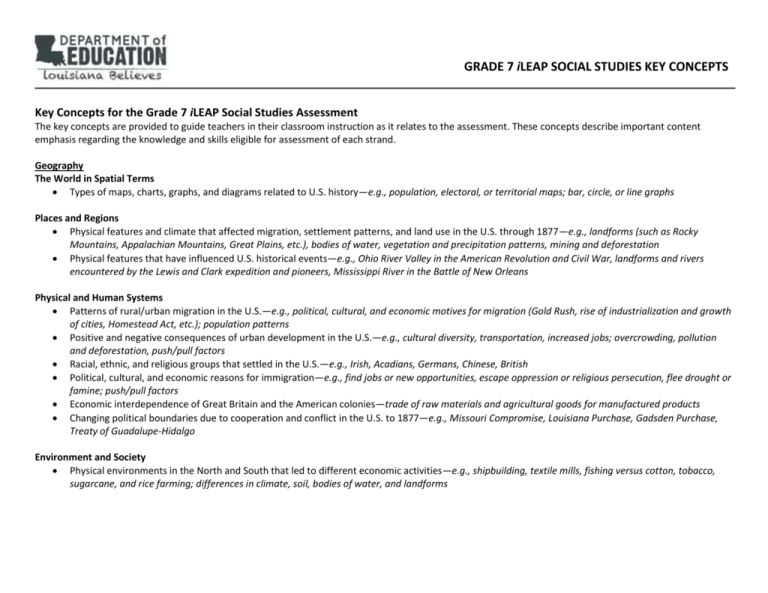
GRADE 7 iLEAP SOCIAL STUDIES KEY CONCEPTS
Key Concepts for the Grade 7 iLEAP Social Studies Assessment
The key concepts are provided to guide teachers in their classroom instruction as it relates to the assessment. These concepts describe important content
emphasis regarding the knowledge and skills eligible for assessment of each strand.
Geography
The World in Spatial Terms
Types of maps, charts, graphs, and diagrams related to U.S. history—e.g., population, electoral, or territorial maps; bar, circle, or line graphs
Places and Regions
Physical features and climate that affected migration, settlement patterns, and land use in the U.S. through 1877—e.g., landforms (such as Rocky
Mountains, Appalachian Mountains, Great Plains, etc.), bodies of water, vegetation and precipitation patterns, mining and deforestation
Physical features that have influenced U.S. historical events—e.g., Ohio River Valley in the American Revolution and Civil War, landforms and rivers
encountered by the Lewis and Clark expedition and pioneers, Mississippi River in the Battle of New Orleans
Physical and Human Systems
Patterns of rural/urban migration in the U.S.—e.g., political, cultural, and economic motives for migration (Gold Rush, rise of industrialization and growth
of cities, Homestead Act, etc.); population patterns
Positive and negative consequences of urban development in the U.S.—e.g., cultural diversity, transportation, increased jobs; overcrowding, pollution
and deforestation, push/pull factors
Racial, ethnic, and religious groups that settled in the U.S.—e.g., Irish, Acadians, Germans, Chinese, British
Political, cultural, and economic reasons for immigration—e.g., find jobs or new opportunities, escape oppression or religious persecution, flee drought or
famine; push/pull factors
Economic interdependence of Great Britain and the American colonies—trade of raw materials and agricultural goods for manufactured products
Changing political boundaries due to cooperation and conflict in the U.S. to 1877—e.g., Missouri Compromise, Louisiana Purchase, Gadsden Purchase,
Treaty of Guadalupe-Hidalgo
Environment and Society
Physical environments in the North and South that led to different economic activities—e.g., shipbuilding, textile mills, fishing versus cotton, tobacco,
sugarcane, and rice farming; differences in climate, soil, bodies of water, and landforms
GRADE 7 iLEAP SOCIAL STUDIES KEY CONCEPTS
Civics
Structure and Purposes of Government
Major purposes of government—e.g., ensure domestic tranquility, provide for the common defense, promote general welfare, secure the blessings of
liberty, make laws
Definition of federalism and structure of a federal system
Characteristics and organization of various forms of government—e.g., absolute or constitutional monarchy, direct democracy, republic, oligarchy,
autocracy, and totalitarian dictatorship
System of checks and balances and the limits of government through separation of power—e.g., presidential veto, judicial review, congressional override
and approval of presidential nominees, presidential appointment of judges, impeachment
Powers of the federal government according to the U.S. Constitution—e.g., print money, establish a postal service, approve treaties, declare war, raise
an army
Powers shared by the federal government and the state governments—e.g., establish courts, tax citizens, pass laws, enforce laws
Structure and powers of the three branches of government and the limits of those powers
Key positions within each branch of government
o Executive—president, vice-president, attorney general, secretary of state and other cabinet secretaries, Joint Chiefs of Staff
o Legislative—Speaker of the House of Representatives, president of the Senate, House and Senate majority leaders
o Judicial—Supreme Court justices, chief justice, federal district judge
Qualifications, terms of office, responsibilities, and limits of power for elected officials at the national level
How a bill becomes a law at the federal level
Foundations of the American Political System
Problems the U.S. faced after the American Revolution that led to the writing of the Constitution—e.g., weaknesses of the Articles of Confederation,
Shays’ Rebellion, Federalist Papers
Similarities and differences of the Articles of Confederation and the U.S. Constitution
Formation of the American constitutional government and the federal union—e.g., Continental Congress, Great Compromise
Arguments and leaders of the Federalists and Anti-Federalists
Ancient governments that influenced American democracy and culture—e.g., Greek direct democracy, Roman Republic, British Parliament
Major ideas expressed in the Mayflower Compact and the Declaration of Independence—e.g., natural/basic rights, self-government, proclamation of
freedom
Principles of government embodied in the U.S. Constitution—e.g., popular sovereignty, respect for individual liberties, checks and balances, due process
of law, separation of powers, consent of the governed
Methods of making changes in a democratic society—e.g., petition, elections, impeachment, civil disobedience (marches, rallies, boycotts, strikes),
compromise, constitutional amendment, recall
Political parties in the American political system—e.g., two-party system, purpose of national convention, party platform
GRADE 7 iLEAP SOCIAL STUDIES KEY CONCEPTS
International Relationships
Political divisions of the world—e.g., nation, state
Processes and strategies nations use to interact—e.g., trade, diplomacy, treaties, tariffs and embargoes, United Nations, economic and humanitarian aid,
sanctions
Ways U.S. foreign policy is formed and carried out—e.g., Monroe Doctrine, presidential summit meetings, military actions, Senate approval of treaties,
negotiations by an ambassador or the secretary of state
Types of foreign policy issues—e.g., war, isolationism, national security, containment
Roles of the Citizen
Qualifications and requirements for U.S. citizenship—e.g., birth in the U.S., birth to American parents abroad, naturalization (residency, citizenship test,
oath of allegiance)
Issues involving important rights and responsibilities of individuals in American society
o Rights—First Amendment freedoms, rights of persons with disabilities, due process of law, other rights in the Bill of Rights
o Responsibilities—military service, jury duty, paying taxes, obeying laws, holding public office
History
United States History
Causes, course, and consequences of the American Revolutionary War—e.g., Stamp Act, Townshend Acts, Tea Act, Intolerable Acts, Battle of Saratoga,
Benedict Arnold, Thomas Paine, Yorktown, Boston Tea Party, Fort Ticonderoga, Declaration of Independence
Compare and contrast the strategies and motivations of the Patriots, Loyalists, and British during the American Revolution—e.g., Sons of Liberty,
Committees of Correspondence, British recruitment of slaves, American merchants
Key figures in the American Revolution—e.g., Benjamin Franklin, Thomas Jefferson, George Washington, Samuel Adams, John Hancock, Patrick Henry,
George Rogers Clark
Effect of the American Revolution on the politics, society, and economy of the U.S.—e.g., national debt, local elections, state constitutions
Issues involved in the creation and ratification of the U.S. Constitution—e.g., Constitutional Convention, Virginia Plan, New Jersey Plan, Connecticut
Compromise, Three-Fifths Compromise, slavery question, addition of a bill of rights
Specific guarantees of the Bill of Rights—e.g., freedom of speech, religion, assembly, press, and petition; right to bear arms; compensation for private
property; rights of the accused (warrants for search and seizure, protection from double jeopardy and self-incrimination, speedy and public trial by jury,
due process of law, right to an attorney, no excessive bail or cruel and unusual punishment); other rights reserved to the people
Provisions of the Monroe Doctrine and its influence on U.S. foreign relations
Effect of westward movement of the U.S. on relations with American Indians and the changes it created—e.g., Oregon Trail, Oregon Territory, expansion
of railroad system, Great Plains, government policy toward American Indians in the early 1800s, removal/resettlement of American Indian nations,
resistance strategies of American Indians
GRADE 7 iLEAP SOCIAL STUDIES KEY CONCEPTS
Concept of Manifest Destiny and its economic, political, social, and religious roots—e.g., Homestead Act, Preemption Act, Transcontinental Railroad,
Gold Rush, Gadsden Purchase
Causes, course, and consequences of the Texas War for Independence and the Mexican-American War
The influence of Jacksonian democracy on the U.S. political system—e.g., Indian Removal policy, Trail of Tears, spoils system (Kitchen Cabinet), support of
increased federal power, national bank
Major technological developments related to land, water, and transportation—e.g., roads, canals, railroads, steamboat, cotton gin, steel plow,
mechanical plow
National policies on a protective tariff, national bank, federally funded improvements (roads, canals, railroads), and educational and prison reforms—
e.g., Bank of the United States, Erie Canal, Cumberland Road, Alexander Hamilton, protective tariffs
Comparison of ways of life in northern and southern states—e.g., rapid urbanization and industrialization in the North, growth of agricultural economy
and slavery in the South
Causes and explanations for new waves of immigration prior to the Civil War—e.g., railroad, potato famine in Ireland, the appeal of gold in California,
political unrest, American (Know-Nothing) Party
Importance of the ideas and reform leaders of the Second Great Awakening— e.g., public education, mental health and prisons, temperance, suffrage,
religion, abolition
Fundamental beliefs of abolitionists—e.g., William Lloyd Garrison, Harriet Tubman, Underground Railroad, John Brown, Harper’s Ferry, Frederick
Douglass, positions of those who favored gradual versus immediate emancipation
Leaders and effects of the major antebellum reform movements—Seneca Falls Convention, woman’s suffrage, Elizabeth Cady Stanton, Susan B. Anthony,
Julia Ward Howe, Dorothea Dix, temperance, Horace Mann
Advantages and disadvantages of the North and the South at the outbreak of the Civil War and their economic, social, and cultural differences

